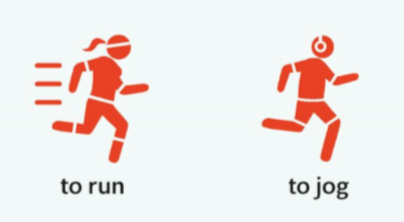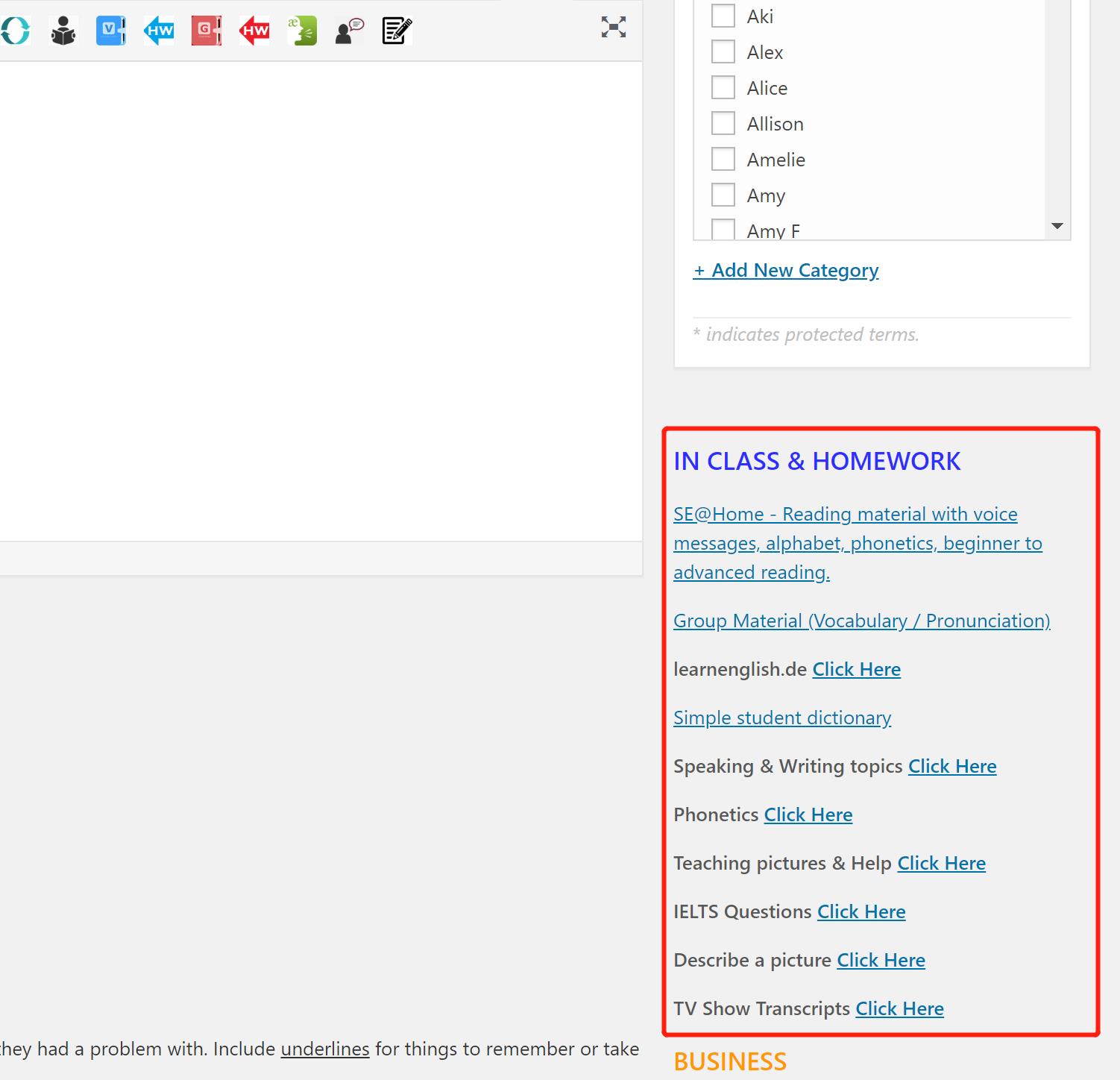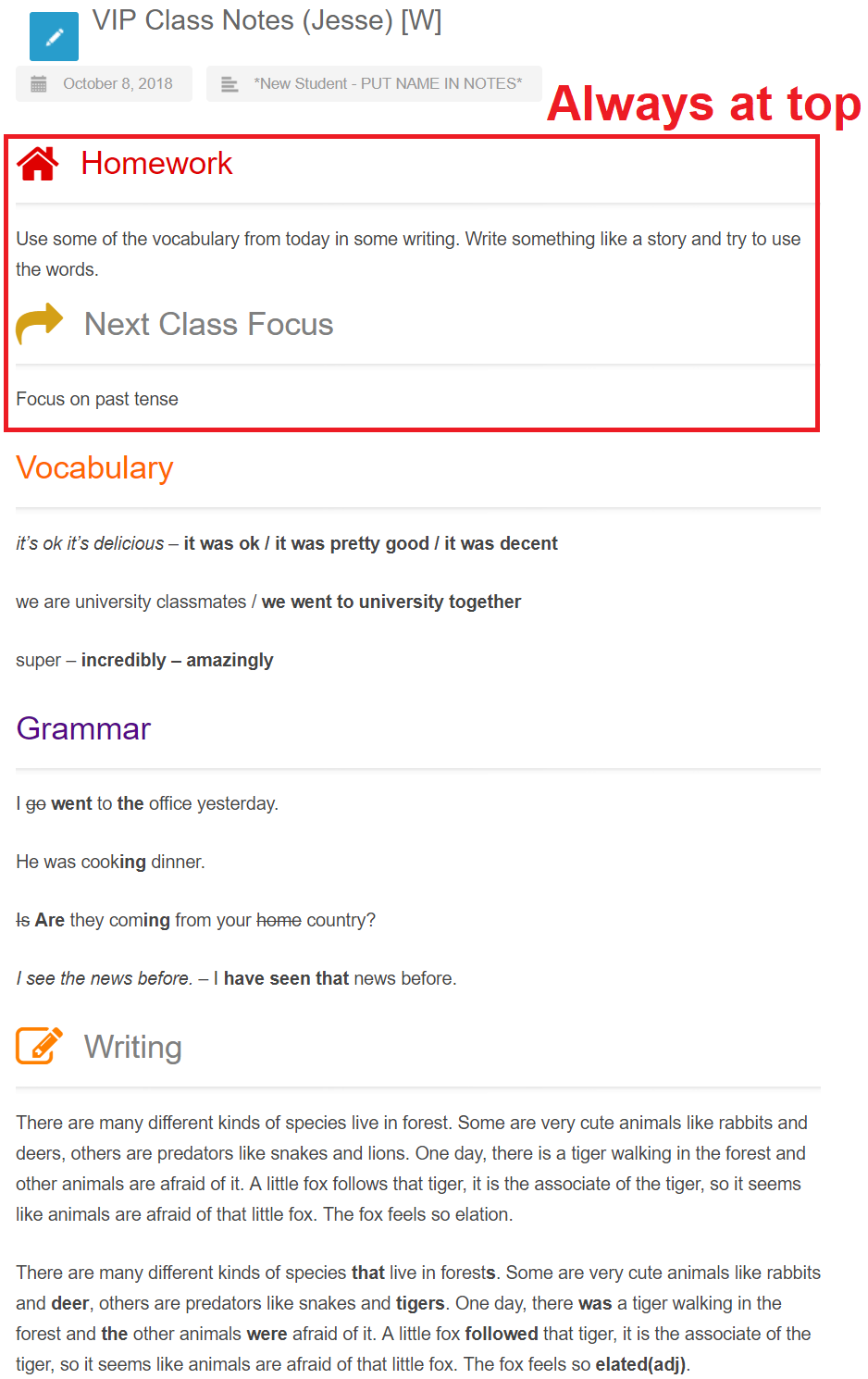SE Consultant Notes Guide
GRAMMAR
Grammar corrections & teaching should come from conversation, and taken from speaking & writing exercise corrections
1 – teaching specific grammar points and writing them in notes (eg. difference between certain prepositions, tense, conjunction usage etc). through conversation & direct questions from students.
2 – correcting in-class speaking or homework writing exercises that are corrected during class, with important grammar points being added to the grammar section of notes.
3 – directly correcting students during conversation or speaking exercises to break habits and encourage self correction – these may not always be written in notes as the student likely already knows it but just needs reminding verbally.
Corrections
From conversation or writing or speaking exercises
Grammar
I go went to the office yesterday.
He was cooking dinner.
Is Are they coming from your home country?
I see the news before. – I have seen that news before.
Note: when correcting writing & speaking, always make small corrections rather than rewriting whole sentences (where possible). The idea is to improve the student’s English to the next level, not to a native level.
Writing Homework Corrections
Writing exercise
There are many different kinds of species live in forest. Some are very cute animals like rabbits and deers, others are predators like snakes and lions. One day, there is a tiger walking in the forest and other animals are afraid of it. A little fox follows that tiger, it is the associate of the tiger, so it seems like animals are afraid of that little fox. The fox feels so elation. But a tiger is always a tiger, at the end of that journey, the tiger eats that little fox because it feels hungry. They will never been peers because they are quite different species and they can’t translate others “language”.
There are many different kinds of species that live in forests. Some are very cute animals like rabbits and deer, others are predators like snakes and tigers. One day, there was a tiger walking in the forest and the other animals were afraid of it. A little fox followed that tiger, it is the associate of the tiger, so it seems like animals are afraid of that little fox. The fox feels so elated(adj). But a tiger is always a tiger, at the end of that journey, the tiger eats that little fox because it feels hungry. They will never be peers because they are quite different species and they can’t translate each others “language”.
In Class Speaking Exercise Corrections
Speaking exercise
You know that I have a kid, mty son 1.5 years old. I bought him a tool, a big one that you can climb to top and foo, up and down. yesterday it arrived and I asked him to play it, actually he a little bit scared, but I think he pretend to be funny because everyone in the family are encouraging him from up to the bottom, and after that he just smile, but its kind of an embarrassing smile so I took a video, for the whole from the start to the end. So everytime I watched the video its really funny.
You know that I have a kid, my son who’s one and a half years old. I ordered him a toy, a big one that you can climb to the top and slide up and down down. Yesterday it arrived and I asked him to play with it, actually he was a little bit scared, but I think he pretended to be happy because everyone in the family was encouraging him to slide down, he did and after that he just smiled, but its kind of an embarrassing smile so I took a video from the start to end. So everytime I watch the video its really funny.
VOCABULARY
Focus on WORD CHOICE and teaching vocab PHRASES
1 – correcting vocabulary that has been misused or is chinglish and suggesting better or more suitable vocabulary during conversation.
2 – teaching new vocabulary that comes from articles, emails, and other content that is useful and relevant to the student’s English learning needs.
3 – upgrading the student’s current vocabulary in speaking and writing exercises by suggesting alternative words and phrases.
Teaching Vocabulary
1 – When giving definitions
Run – a velocity of bipedal movement that is increased beyond a walk. Run – pao bu / walk < jog < run < sprint


Direct Corrections
Vocabulary
it’s ok it’s delicious – it was ok / it was pretty good / it was decent
we are university classmates / we went to university together
super – incredibly – amazingly
we should get lunch together with you
we created made plans
eg: We made plans to go to Beijing.
it will get red
eg: My eyes will get red if I sit too close.
New Vocabulary
1. You MUST write EXAMPLE SENTENCES for each new vocabulary word.
2. Use Learnersdictionary.com (APP available for 30 Yuan) for simple English definitions. Or create your own simple definition with easy words that the student can understand
regulate (v) – to control something, usually by making rules or laws.
eg: It is important to regulate medicine so people know it is safe.
eg: They need to regulate some websites.
cream (n) – a very thick liquid or soft substance, can be from a liquid
eg: I put a little cream in my coffee.
eg: I like milk coffee, it is very creamy.
comfortable (adj) – shu fu
eg: this chair is very comfortable
eg: the weather today is so comfortable!
“What goes around comes around” – if you do something bad, bad things will come to you in the future
Upgrading Words – Speaking Exercise / Writing Homework
Use speaking text or written text and upgrade vocabulary from corrected version.
Original
You know that I have a kid, mty son 1.5 years old. I bought him a tool, a big one that you can climb to top and foo, up and down. yesterday it arrived and I asked him to play it, actually he a little bit scared, but I think he pretend to be funny because everyone in the family are encouraging him from up to the bottom, and after that he just smile, but its kind of an embarrassing smile so I took a video, for the whole from the start to the end. So everytime I watched the video its really funny.
Corrected
You know that I have a kid, my son who’s one and a half years old. I ordered him a toy, a big one that you can climb to the top and slide up and down down. Yesterday it arrived and I asked him to play with it, actually he was a little bit scared, but I think he pretended to be happy because everyone in the family wasencouraging him to slide down, he did and after that he just smiled, but its kind of an embarrassing smile so I took a video from the start to end. So everytime I watch the video its really funny.
Upgraded
You know that I have a kid [ child / son ], my son who’s one and a half years old [ one and a half / 1.5 years old / 18 months old ]. I ordered [ bought ] him a toy, a big [ large / huge ] one that [ which ] you can climb to the top and slide down. Yesterday [ the other day / a day or so ago ] it arrived [ was delivered ] and I asked him to [ got him to / requested that he ] play with it…
Choose words & phrases that the student isn’t very familiar with or that are particularly important, and teach them below.
18 months old / 18 month old
eg. I have an 18 month old baby
eg2. My son is 18 months old
which / that
eg. I have a computer which I use every day.
eg2. I have a computer which is black.
The other day – a day recently
eg. I went to the grocery store the other day and bought some vegetables
PRONUNCIATION
When focusing on pronunciation ensure that ONLY pronunciation is the focus. This means simple reading texts and simple conversation is a must. Pronunciation for individual words taught in class can be added to the vocabulary entry.
1 – teaching mouth movement techniques & accent by reviewing the phonetic alphabet, English alphabet, and reading simple articles, focusing on vowel and consonant sounds and movements.
2 – correcting pronunciation of individual words from conversation and reading articles, speaking exercises, or writing homework.
3 – teaching the joining and connection of words by reading simple articles with the help of hand-drawn illustrations to show connection both visually and audibly.
Beginner, Intermediate, and Advanced level articles can be found on the right hand side of the new post page of the SE website.

Corrections & Teachings
describe – des kr eye b
pronounce – pro now nsss
Long A sound = aaaeeeee
remember the “eeee” sound at the end of the “A” like “play / game / train”
HOMEWORK
Ensure homework is based on today’s class AND/OR the student’s specific English needs
A: Grammar (Automatically generated instructions)
![]()
Homework
B: Vocabulary (Automatically generated instructions)
![]()
Homework
C: Custom Homework
![]()
Homework
1 – Custom instructions – eg. Read the plot from https://en.wikipedia.org/wiki/The_Bicycle_Thief_(Modern_Family) and write down any words you don’t know. Talk about them next class.
2 – Vocabulary based custom HW – eg. Write about your trip next week and try to use higher level words for some of the simple words you use.
3 – Grammar based custom HW – eg. Write about the topic we discussed today and focus on using “have done” and “had done”
NEXT CLASS FOCUS
This is an instruction to both the student and next class teacher to focus on a particular exercise or area of English in their next class

Next Class Focus
Focus on L and R pronunciation by reading from SE @ HOME and making sure she is moving her mouth correctly.
Of course any instruction like this is fine, as long as the teacher has a clear idea of what to do next class.
Other Notes Formatting
Example notes layout

Strikethrough:
Word = Big Mistake
Italics:
Word = Student’s words / Mistakes
Bold:
Word = Correction / Missing Word or Phrase
Underline:
Word? = A Teacher’s Question for Student
Conversation:
USE INDENT BUTTON
![]()
Teacher: Are you busy today?
Student: I no busy. – I’m not busy.
Teacher: Do you have any free time later?
Student: Yes, have time. – Yes, I have time later. What do you need?
Teacher: Can we review the plan? I still have some questions.
Student: Yes, is nothing. Can review with you together. – Yeah, no problem. We can review
it with you together.

Comments are closed.